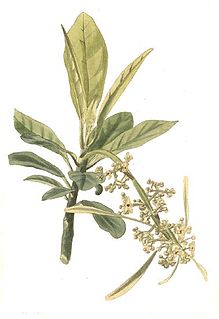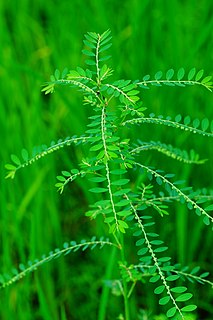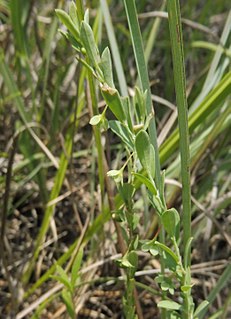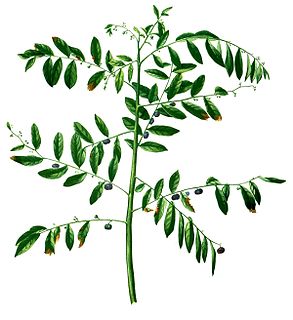
Phyllanthus is the largest genus in the flowering plant family Phyllanthaceae. Estimates of the number of species in this genus vary widely, from 750 to 1200. Phyllanthus has a remarkable diversity of growth forms including annual and perennial herbs, shrubs, climbers, floating aquatics, and pachycaulous succulents. Some have flattened leaflike stems called cladodes. It has a wide variety of floral morphologies and chromosome numbers and has one of the widest range of pollen types of any seed plant genus.

Phyllanthus emblica, also known as emblic, emblic myrobalan, myrobalan, Indian gooseberry, Malacca tree, or amla from Sanskrit amalaki is a deciduous tree of the family Phyllanthaceae. It has edible fruit, referred to by the same name.

Omphalea is a plant genus of the family Euphorbiaceae first described as a genus in 1759. It is native to tropical parts of the Americas, the West Indies, Asia, Australia, and Africa.
Pseudobombax millei, the beldaco, is a species of flowering plant in the family Malvaceae. It is found only in Ecuador. Its natural habitats are subtropical or tropical dry forests and subtropical or tropical moist lowland forests. It is threatened by habitat loss.
Mikania millei, the poroto angu, is a species of flowering plant in the Asteraceae family. It is endemic to Ecuador. Its natural habitat is subtropical or tropical high-altitude grassland. It is threatened by habitat loss.

Pentacalia is a genus of flowering plant in the Asteraceae family. About 34 members of this genus appear to be located in the South American county Ecuador, where they are threatened by habitat loss. The genus contains approximately two hundred species, which are distributed from Mexico to northern South America.
Pentacalia millei is a species of flowering plant in the Asteraceae family. It is found only in Ecuador. Its natural habitats are subtropical or tropical moist montane forests and subtropical or tropical high-altitude grassland. It is threatened by habitat loss.
Phyllanthus manono, also known as manono or mahame in Tahitian, is a species of small tree in the Phyllanthaceae family. It is endemic to the Windward Society Islands in French Polynesia, where it is found on the islands of Tahiti and Moorea. Compared to other species of Phyllanthus in the Society Islands, P. manono is found in relatively low-elevation areas, including some disturbed environments.
Phyllanthus nadeaudii is a species of tree in the Phyllanthaceae family. It is endemic to the island of Moorea in French Polynesia, where it is found on several mountains above 420 meters elevation. P. nadeaudii the species may be the only species of tree endemic to this island.
Peperomia millei is a species of plant in the Piperaceae family. It is endemic to Ecuador.

Phyllanthus arbuscula is a species of plant in the Phyllanthaceae family. It is endemic to Jamaica.
Phyllanthus cladanthus is a species of plant in the Phyllanthaceae family. It is endemic to Jamaica.
Phyllanthus pavonianus, synonym Phyllanthus haughtii, is a species of plant in the Phyllanthaceae family. It is native from south Ecuador to north-west Peru. Its natural habitat is subtropical or tropical moist montane forests. Under the synonym Phyllanthus haughtii, it has been regarded as "endangered".
Phyllanthus revaughanii is a species of flowering plant in the family Phyllanthaceae, native to the Mascarene Islands and the Mozambique Channel Islands. Its natural habitat is rocky shores.
Phyllanthus sponiifolius is a species of plant in the Phyllanthaceae family. It is native to Colombia and Ecuador. Its natural habitat is subtropical or tropical moist montane forests.

Phyllanthus niruri is a widespread tropical plant commonly found in coastal areas, known by the common names gale of the wind, stonebreaker or seed-under-leaf. It is a relative of the spurges, belonging to the genus Phyllanthus of the family Phyllanthaceae.

Phyllanthus polygonoides, known as smartweed leaf-flower or knotweed leafflower, is an herbaceous perennial plant in the family Phyllanthaceae. It grows from 10 to 50 centimeters in height. It is native to the United States and northern and central Mexico.
Phyllanthus polyspermus is a bush species first described Jean Louis Marie Poiret, with its current name after Schumacher and Thonning; it is included in the family Phyllanthaceae. No subspecies are listed in the Catalogue of Life.

Phyllanthus reticulatus is a plant species described Jean Louis Marie Poiret; it is included in the family Phyllanthaceae.











